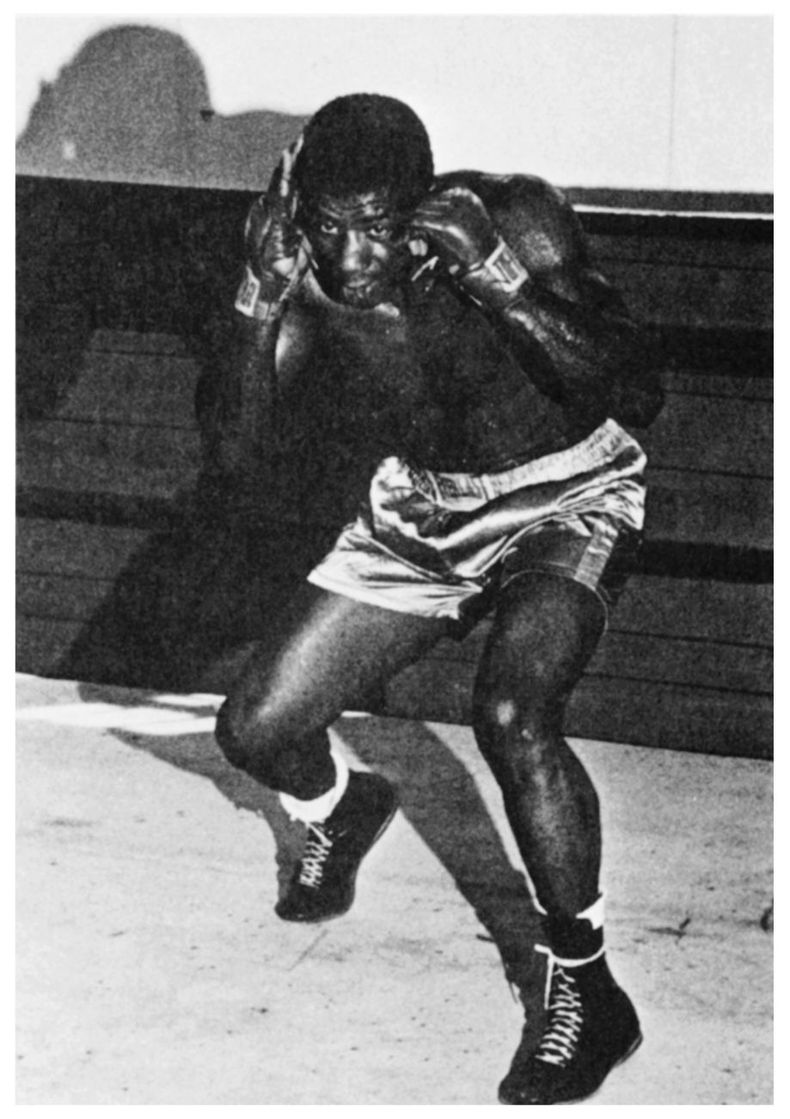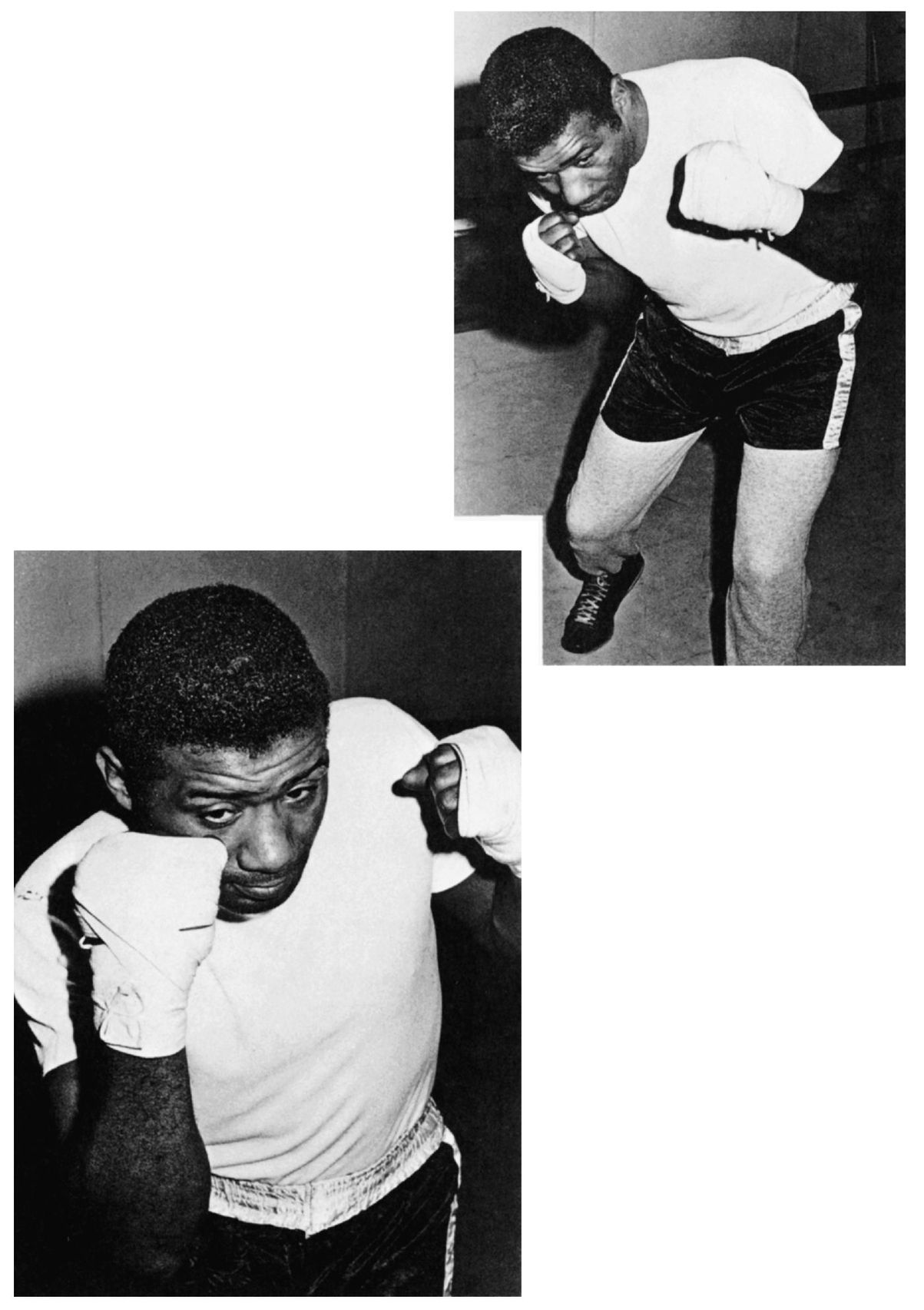
IN THE BASIC STANCE . . . the feet are properly spaced so as to maintain balance and the hands are held high for both defense and offense.

2
THE BASICS OF STANCE AND MOVEMENT
Correct stance and movement are the foundation on which to build your offense and defense. Just as a baby learns to crawl before it walks and to walk before it runs, so the beginning boxer must learn the correct stance before learning how to move about the ring, and he must know how to move before concerning himself with punching or with defense.
THE BASIC STANCE
In the basic stance the feet are comfortably apart with the left foot in front of the right and slightly turned in. The distance between your feet should be whatever gives you a solid, balanced feeling; but 12 to 14 inches should be a minimum, so that you cannot be pushed off-balance easily. This position puts you sideways, with the left side of your body in a straight line with your left leg. This offers a smaller target to your opponent.

THE POSITION OF THE FEET . . . in the basic stance. Your left foot should be flat on the floor and slightly turned in. Your right foot is behind, with the heel off the floor. Reverse these positions if you are left-handed.
Keep your left foot flat on the floor. Your right heel, however, must stay off the floor. Keep your weight evenly distributed between the soles of both feet.
When you back up or move to your right, your right foot moves first, then your left. When you move forward or move to your left, your left foot slides in that direction, followed by your right. Always slide forward and backward without crossing your feet. In this manner, you avoid being off balance. If you get off balance, your opponent merely has to shove you to put you on the canvas.
As you move, keep coming back to the basic stance position, the quicker the better. Remember to stay on the toes of your right foot, never placing that foot flat on the canvas. And never bring your feet together or cross them.

YOUR HEAD POSITION . . . offers protection to your jaw and chin, making them poor targets. Here I am showing my pupil how to hold his head properly.

MAINTAIN THE BASIC STANCE . . . even while moving around. Here I’m showing my pupil how to slide forward without losing his balance.
Now as to the position of the upper part of your body: keep your left shoulder up and bend your head to the left, so that your chin is hidden in the hollow of your shoulder. It helps, too, if you crouch a bit. This offers protection to your jaw and chin, making them poor targets.
Hold your right hand high and close in beside your chin. Hold your left hand up at all times. Keep your left elbow close to your body to protect your mid-section.

FIGHTING OUT OF A CROUCH . . . is an effective method for a fighter who is short or of average height. The crouch makes your body a smaller target, and exploding out of the crouch is an effective offense.
Always come back to this basic position, no matter what you do or where you go. You have to move fast, because whenever you throw a punch you leave yourself open temporarily for a counterpunch. Boxing is a matter of action and interaction. It is impossible to keep from exposing some part of yourself from time to time. So you must learn to be fast in returning to your basic defensive position before your opponent has had time to see your opening and counter your move. An important consideration for any beginner is whether he should stand in the classic position that I’ve just described or fight out of a crouch. Which position you choose depends upon your particular build and physical attributes. If you are tall and have long arms and legs, your height and reach may enable you to land punches while remaining out of your opponent’s reach. Anything you can do to emphasize these advantages will help you. So you’d be better off in the classic stance, with the left side of your body forming a straight line with your left leg and your chin dropped forward and held tight against your breastbone. On the other hand, if you’re short, with short arms and legs, then your best bet would be to make yourself into a smaller target by crouching. You’ll find that you can explode out of a crouch in an effective offense. And, on defense, you will be harder to hit.
If you have an average build—neither very tall nor very short—I’d advise you to learn both methods of fighting, because the situation may arise when you’ll need to change your stance against opponents with varying builds and fighting styles.
Keep your body relaxed. If you tighten up, you’ll get tired, but if you keep your body limber, you’ll be able to do a lot more. The only time you should tighten up is when your opponent is throwing punches at you. When you’re throwing punches or moving, try to be as limber as possible.
When you’re first getting started, it’s a good idea to pay a great deal of attention to your footwork, so that it becomes second nature to you. Unless you work on your footwork, you’ll probably get tangled up when you try to move around in an actual fight. First practice moving in and out; then try to move from side to side. Then try to speed up your changing movements without getting off on the wrong foot.
BOBBING AND WEAVING
Footwork is not the only type of movement you must learn. As a beginner you also need to master bobbing and weaving, the side-to-side and up-and-down movement of the body that is useful on both defense and offense (Diagram 4). Bobbing and weaving is the art of slipping and sliding punches. It is also called “ducking” or “avoiding.” After fighting for awhile, you may decide that this way of fighting is not for you. But even the boxers who prefer to fight in the classic stand-up manner find that, sometimes, a bit of bobbing and weaving comes in handy. I think it’s important for every beginner to learn this technique.
When you’re bobbing and weaving, keep your eyes on your opponent at all times. Some fighters look their opponents in the eye; others watch the chest; still others look at their opponent’s feet. I find that by looking at my opponent’s chest I can tell everything that’s going on. But I know that the other methods work better for other fighters.
Whatever target you train for, keep your eyes glued on that spot, the place where you know what’s going on. This takes plenty of practice. Many times I’ve gotten in trouble because I took my eyes off my opponent’s chest and looked at the floor instead. So I keep working, training myself to watch the chest, to make sure that I’m never caught by surprise in an actual fight.
You can practice bobbing and weaving in front of a mirror or by ducking the swinging, heavy bag or a smaller bag. The smaller bag that I use is made to go from side to side or forwards and backwards, and is perfect for bobbing and weaving practice.
It takes split-second timing to avoid punches being thrown at you. And just as important as making your opponent miss is being able to be in a position yourself to counterattack. Always be a moving target. Shift your feet, go in and out, move side-ways. Move your upper body, too, as well as your head and shoulders. Movement is your best defense when your opponent gets through your guard.

DIAGRAM 4. Bobbing and weaving.

SPLIT-SECOND TIMING . . . is necessary if you are to avoid the punches being thrown at you. Bobbing and weaving makes you harder to hit because you’re a moving target.

SLIPPING A PUNCH . . . is an important technique for every beginner to learn.
BOBBING AND WEAVING . . . is primarily a defensive measure, but it can also be used offensively. To offset the longer reach of your opponent, you can punch out of a weave, as I’m preparing to do here.

Practice moving your head and shoulders without moving the rest of your body. Bend your knees and rock on your toes. Go into a deep crouch and move all over the ring. Move around smoothly without jumping or jerking.
Bobbing and weaving can be an effective offensive manuever, too. It allows you to escape your opponent’s blows and still remain in range for a counterattack. For example, you can drop your body forward from the waist so that your opponent’s punches pass harmlessly over your head. Carrying your hands high, with elbows down, you are ready in such a case to come right back with your own countering punches. Punching out of a weave can give you added leverage as you swat from side to side.